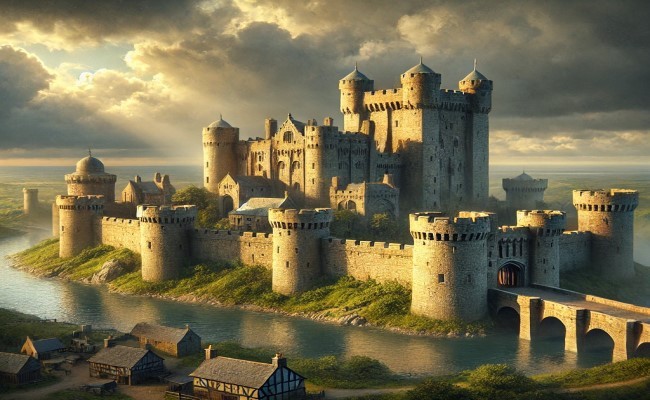The Majestic History and Cultural Significance of Castles

Castles have long captured the human imagination, standing as symbols of power, protection, and mystery. These majestic structures, often perched atop hills or surrounded by moats, evoke images of medieval knights, royal banquets, and epic battles. But beyond their romanticized image, castles played a crucial role in the history of many nations, serving as fortresses, residences, and administrative centers. In this article, we explore the history, architecture, and cultural significance of castles, as well as their enduring presence in art and popular culture.
The Origins and Evolution of Castles
The concept of castles began to take shape in Europe during the early medieval period, around the 9th and 10th centuries. The collapse of the Roman Empire left much of Europe fragmented, with power shifting from centralized governments to local lords and nobles. To protect their lands and assert their dominance, these lords began building fortified structures that would later evolve into the castles we recognize today.
Early castles were primarily made of earth and wood, featuring motte-and-bailey designs. The motte was a raised mound of earth topped with a wooden keep, while the bailey was an enclosed courtyard surrounded by a protective ditch or palisade. These early castles were relatively simple but effective in providing defense against raiders and rival lords.
As time passed, the design and construction of castles became more sophisticated. By the 11th and 12th centuries, stone had largely replaced wood as the primary building material, leading to the development of the iconic stone castles. These structures featured thick walls, massive towers, and fortified gates, making them nearly impregnable. The Norman Conquest of England in 1066, for example, led to the construction of numerous stone castles across the British Isles, including the famous Tower of London.
Architectural Features of Castles
Castles are known for their distinctive architectural features, many of which were designed with both defense and aesthetics in mind. One of the most recognizable features of a castle is its keep, the central tower that served as the last line of defense and the lord’s residence. Keeps were often built with thick walls and narrow windows, making them difficult to breach.
The curtain wall is another key element of castle architecture. These high, thick walls surrounded the castle and were often punctuated by towers, which provided additional defensive positions and a vantage point for archers. The towers themselves could be round or square, with round towers being more resistant to attack due to their ability to deflect projectiles.
The gatehouse was perhaps the most vulnerable part of a castle, as it was the main entrance. To defend it, castle builders added various features such as portcullises—heavy, vertically sliding doors made of iron or wood—and drawbridges that could be raised to prevent enemy entry. Some castles also featured moats, and water-filled ditches that further deterred attackers.
Inside the castle, great halls served as the center of social and political life. These large, open rooms were where the lord would host feasts, hold court, and entertain guests. The hall was often richly decorated, reflecting the wealth and status of the castle’s owner.
The Role of Castles in Medieval Society
Castles were not just military fortifications; they were also the hubs of medieval society. The lord of the castle wielded significant power, overseeing the administration of the surrounding lands, dispensing justice, and collecting taxes. The castle was a symbol of the lord’s authority and a physical manifestation of his control over the region.
For the local population, the castle provided protection in times of war. Villagers could seek refuge within its walls during attacks, making the castle a vital part of the community’s defense. Castles also played a role in the economy, often serving as the center of trade and commerce. Markets and fairs were frequently held near castles, attracting merchants and craftsmen from surrounding areas.
Castles in Art and Culture
The enduring allure of castles extends beyond their historical significance; they have also become iconic symbols in art and popular culture. Castles have been depicted in countless works of art, from medieval manuscripts to modern-day paintings. These depictions often emphasize the grandeur and mystery of castles, highlighting their role as both fortresses and residences.
Paintings of castles often capture these structures in dramatic landscapes, with towering walls and majestic towers silhouetted against stormy skies or bathed in the golden light of sunset. These images evoke a sense of nostalgia for a bygone era when knights and kings ruled from these imposing fortresses. Artists like J.M.W. Turner and Caspar David Friedrich have created some of the most famous paintings of castles, each bringing their unique perspective to the subject.
In literature, castles are frequently used as settings for epic tales of heroism, romance, and intrigue. From the dark, mysterious castles of Gothic novels to the enchanted castles of fairy tales, these structures have provided the backdrop for countless stories that have captivated readers for centuries.
In modern popular culture, castles continue to inspire. They are featured in movies, television shows, and video games, often as the lairs of villains or the homes of heroes. The fantasy genre, in particular, has embraced the imagery of castles, with works like The Lord of the Rings and Game of Thrones drawing heavily on the medieval aesthetic.
The Legacy of Castles
Today, many castles have been preserved as historical sites, attracting millions of visitors each year. These structures stand as monuments to a past era, offering a glimpse into the lives of the people who built and inhabited them. While the military significance of castles has long since faded, their cultural and architectural legacy continues to endure.
In conclusion, castles are more than just relics of the past; they are powerful symbols of history, culture, and imagination. Whether as formidable fortresses or romantic ruins, they continue to captivate and inspire, reminding us of a time when these majestic structures dominated the landscape and the lives of those who lived in their shadow. Through paintings of castles and their presence in popular culture, the legacy of these incredible structures lives on, bridging the gap between the past and the present.



